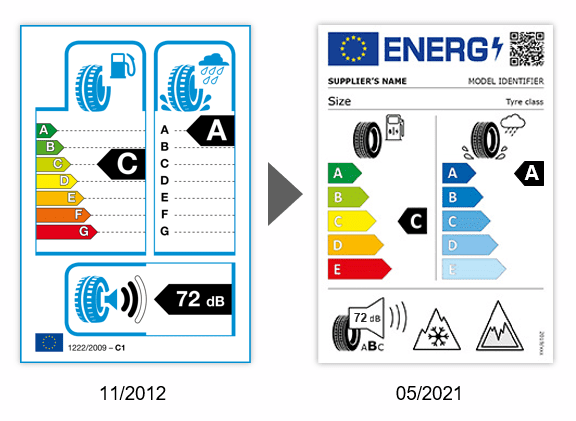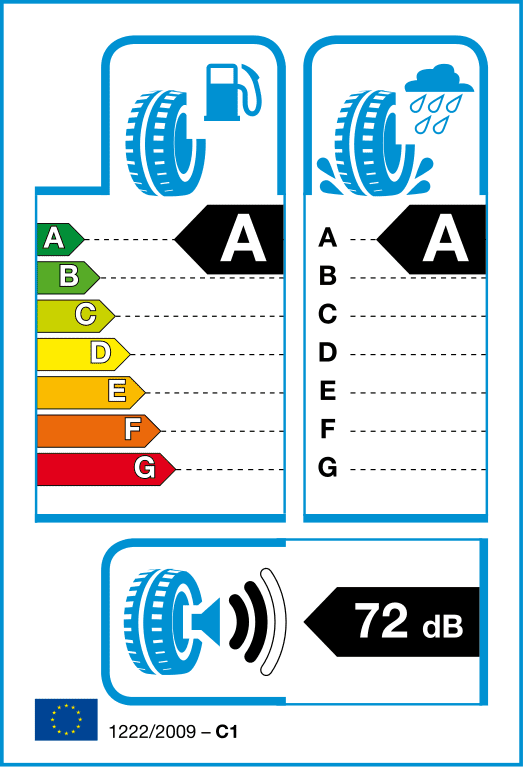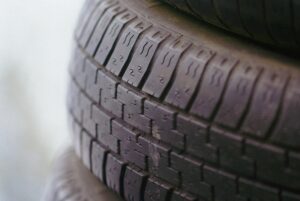
In 2012, the European Union introduced a ground-breaking regulation concerning tyre labelling, aiming to offer comprehensive information on tyre safety, reduce tyres’ environmental impact, and promote road safety.
This initiative was designed with the motorist in mind, simplifying the comparison of different tyres by their performance characteristics.
Fast forward to 2021, and this regulation has evolved, reflecting advancements in technology and driving the development of new tyre standards.
From 1st May 2021, a revised tyre labelling regulation came into effect. This meant that for every tyre sold within Europe, manufacturers are now required to specify the tyre’s performance against updated classifications.
These include fuel efficiency, wet grip, external rolling noise, and whether the tyres meet specific standards for severe snow conditions and grip on ice.
Similar to the energy labels found on white goods, these tyre labels provide easily comparable information, allowing consumers to make informed decisions based on a scale from A (best) to E (worst).
This represents a significant shift from the previous scale, which ranged from A to G. The regulation, however, exempts certain tyre types, including T-type temporary use tyres, professional off-road tyres, racing tyres, and tyres specifically designed for vehicles registered before October 1990.
Understanding the New Tyre Labels
The design and information provided by the new tyre labels are aimed at standardising tyre information across brands and tread patterns.
By offering clear, understandable diagrams and ratings, motorists can now gauge a tyre’s performance attributes at a glance, empowering them to choose tyres that best suit their needs and preferences.

The Design and Information of Tyre Labels
These labels are instantly recognisable and formatted to mirror the simplicity and clarity of energy labels. Each label provides essential information on a tyre’s fuel efficiency, wet grip performance, and external rolling noise.
Furthermore, new additions include icons indicating whether a tyre is suitable for severe snow conditions or has adequate grip on ice.
Exclusions from the Regulation
It’s important to note that the regulation does not cover all tyre types. T-type temporary use tyres, professional off-road tyres, racing tyres, and tyres designed for cars registered before October 1990 are exempt.
This ensures the regulation focuses on tyres used by the majority of motorists, providing relevant and actionable information for everyday use.
Detailed Explanation of Tyre Label Components
Fuel Economy
Fuel Economy Labelling
Tyre labels for fuel economy range from A to E, with A-rated tyres being the most fuel-efficient. This rating system highlights the relationship between tyre performance and fuel consumption, encouraging consumers to consider the environmental impact of their tyre choices.
Impact on Fuel Consumption and Costs
The fuel economy rating of a tyre directly affects the vehicle’s fuel consumption and, by extension, the owner’s running costs and the vehicle’s carbon footprint.
For instance, a vehicle fitted with A-rated tyres could see a significant reduction in fuel costs compared to one equipped with E-rated tyres over the same distance.
Wet Grip
Wet Grip Labelling
The wet grip rating, also ranging from A to E, informs motorists about a tyre’s performance in wet conditions, particularly its ability to stop in the shortest possible distance. This rating is crucial for safety, as it directly impacts the vehicle’s braking efficiency in rainy weather.
Safety Implications
Understanding a tyre’s wet grip rating can be a lifesaver, literally. Tyres with an A rating demonstrate the shortest stopping distances on wet roads, significantly reducing the risk of accidents compared to tyres with lower ratings.
Noise
Noise Labelling
The noise level of tyres, as indicated on the tyre label, is an important factor, especially in urban areas where traffic noise contributes significantly to environmental noise pollution.
The label’s sound wave bars and decibel (dB) rating offer a clear indication of the tyre’s noise emission, allowing motorists to make choices that can reduce the overall noise pollution of their vehicles.
An A-rated tyre is considerably quieter than a B-rated tyre, contributing to a more peaceful and less intrusive driving experience.
Not only does this improve comfort for the driver and passengers, but it also benefits the wider community by contributing to lower levels of noise pollution.
New Additions to Tyre Labels
The latest updates to tyre labelling regulations introduce new icons that provide additional information about a tyre’s performance in specific conditions:
-
Severe Snow Conditions: An icon depicting a snowflake indicates that the tyre meets established standards for use in severe snow conditions. This is crucial information for motorists in regions prone to heavy snowfall, ensuring that they are equipped with tyres capable of handling such demanding conditions.
-
Grip on Ice: Another new icon shows a stylised ice crystal, signifying that the tyre has been tested and meets criteria for grip on ice. This addition is particularly relevant for drivers in icy climates, offering peace of mind when navigating roads that are prone to freezing.

These new icons supplement the existing data provided on tyre labels, giving motorists a more comprehensive understanding of a tyre’s capabilities and ensuring that they can make choices suited to their specific driving environments and conditions.
The Importance of Being Tyre-Savvy
Being informed about the specifics of tyre labelling is more than just a matter of compliance with regulations; it’s about enhancing road safety, optimising fuel efficiency, and making environmentally conscious decisions.
Understanding the implications of each component of the tyre label allows drivers to select tyres that not only suit their driving habits but also contribute to the overall safety and efficiency of their vehicle.
Benefits of Understanding Tyre Labels
-
Enhanced Road Safety: Choosing tyres with superior wet grip and snow/ice performance ratings can dramatically improve a vehicle’s handling and braking in adverse conditions, reducing the risk of accidents.
-
Reduced Fuel Costs: Opting for tyres with a higher fuel economy rating can lead to significant savings on fuel expenses over the life of the tyres, making it a financially smart choice in the long run.
-
Environmental Impact: Selecting energy-efficient tyres contributes to reduced carbon emissions, aligning with broader goals of environmental sustainability and responsibility.
Resources for Tyre Maintenance and Safety
Several resources are available to motorists looking to deepen their understanding of tyre safety and maintenance:
-
Michelin: Known for their commitment to tyre safety and quality, Michelin provides extensive information on tyre selection and maintenance, ensuring that their tyres deliver optimal performance throughout their lifespan.
-
Kwik Fit: As the UK’s leading fast-fit supplier of tyres, Kwik Fit offers a free, no-obligation tyre check at their centres nationwide. Their trained technicians carry out comprehensive inspections, and their website is a treasure trove of resources on maintaining correct tyre pressure, checking tread depth, and identifying signs of tyre damage.
Conclusion
The recent changes to tyre labelling regulations mark a significant step forward in empowering motorists with the information needed to make informed decisions about their tyres.
By understanding the various components of the tyre label, drivers can select tyres that offer the best combination of safety, efficiency, and environmental friendliness.
Armed with knowledge and the right resources, motorists can maintain their tyres in peak condition, ensuring safety on the road for themselves and others.
As we move towards a future where road safety and environmental sustainability become increasingly intertwined, being tyre-savvy is not just beneficial—it’s essential.






